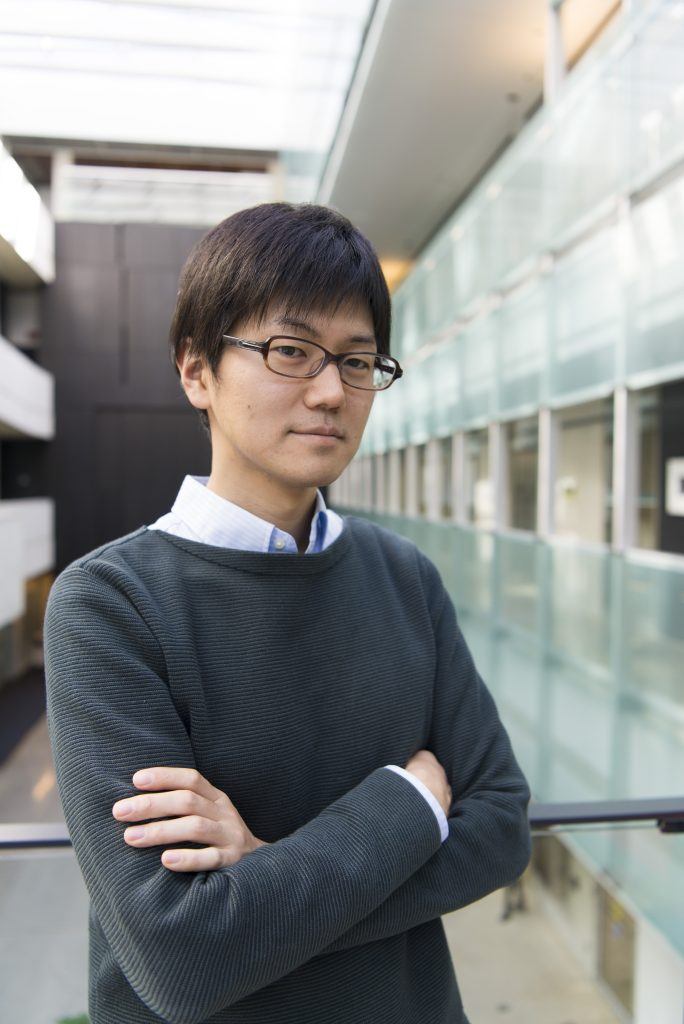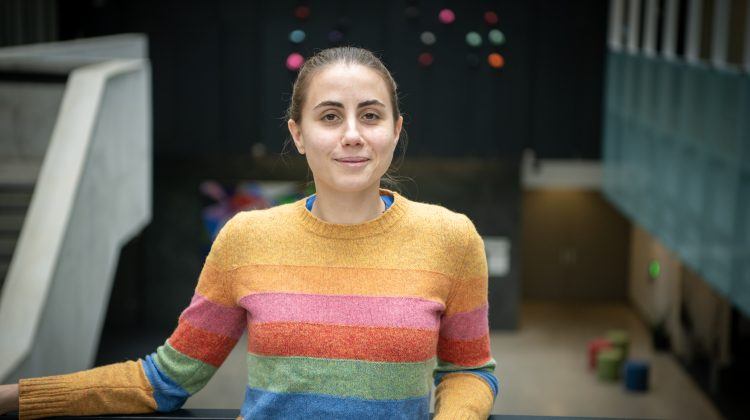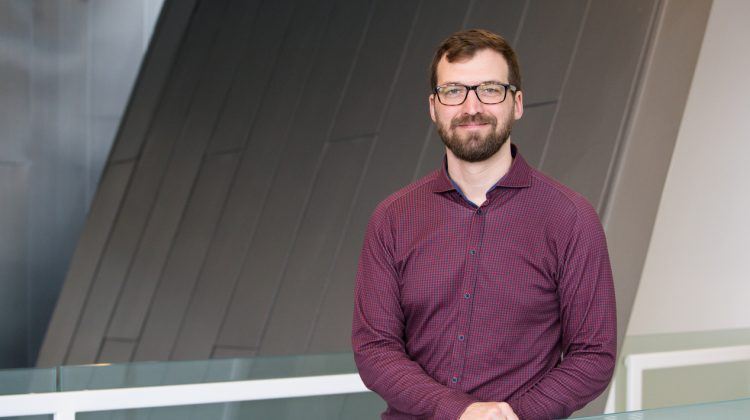Black holes enter the laboratory
A new protocol puts the black hole information paradox to the test in a laboratory – and promises to drive progress in quantum technologies here on Earth.

Beni Yoshida, a Perimeter faculty member and expert in quantum information, is musing about secrets, spaceships, and black holes.
“Let’s say you have a secret diary, and you want to destroy it,” he says. “You decide the surest way is to power up your spaceship and throw it into a black hole. Now I come along, and I want to reconstruct what was in the diary. Is that possible?”
That may sound like an outlandish question, but it’s not a new one. People have been trying to solve this puzzle since Stephen Hawking first formulated it almost 50 years ago. Now, Yoshida says he has an answer. It’s a yes.
What’s more, it’s a yes that can finally be tested.
So. Sadly for your secrets, your diary can be recovered. Happily for physics, the protocol Yoshida developed to recover quantum information from black holes has become a powerful experimental tool. This tool can be used to investigate many kinds of quantum systems and might one day help build practical quantum technologies.
The black hole information paradox
This question – whether information is lost when it falls into a black hole – pits gravity against quantum mechanics. Gravitationally, we know that once your diary crosses the black hole’s event horizon, it can’t come back. But quantum theory says that information can never be lost. On the face of it, both can’t be true. This, then, is not just a puzzle, but a paradox: the black hole information paradox.
The black hole information paradox has occupied physicists for the best part of half a century. Like many broken places in physics, it’s a place where breakthroughs happen: the puzzle has driven progress in every subfield it touches.
Beni Yoshida wasn’t even born when the black hole information paradox was developed. But he’s been on its track for years. The work has taken him – and the field – on a long and surprising journey.
The first milestone came in 2015, when Yoshida and his collaborators developed a proof that quantum information does indeed escape from a black hole.
The escape hatch is Hawking radiation. Throughout the universe, even in what appears to be empty space, quantum fluctuations create particle/anti-particle pairs. Usually, these pairs of particles pop into existence, then annihilate each other and vanish again. Near black holes, something special happens: one half of the pair falls into the black hole, and the other escapes. Yoshida’s 2015 proof shows that these escaping particles contain a copy of all the information that falls into the black hole.
But, of course, there’s a huge step between proving that quantum information escapes and knowing how to take that shredded information and paste it back together. Researchers across the field were generally pessimistic about the chances of reassembly – but in 2017, Yoshida and Alexei Kitaev of the California Institute of Technology developed a protocol for recovering information from a black hole.
Both the 2015 proof and the 2017 protocol are based in quantum information theory and specifically involve a phenomenon known as quantum information scrambling, which is thought to take place inside black holes.
Quantum scrambling in black holes
An intuitive picture of “scrambling” might look something like the tumbling cage full of numbered balls used in bingo halls. But quantum scrambling is different: each “ball” is a qubit, and it doesn’t just bounce around, it interacts with other qubits. No classical analogy can quite capture this, but it’s more like balls of paint bouncing and mixing than bingo numbers tumbling. The information, like the paint, spreads out with each bounce. A physicist would say the information is becoming less localized. That is, the information can no longer be described by drawing out and looking at one particular ball.
As more and more qubits interact in broader systems, the information smears out until it’s entirely mixed, and the system can only be considered as a whole. Inside a black hole, all quantum information is thought to be completely scrambled in this way.
It may sound as if this scrambled information is lost, but in fact, it’s encoded in quantum correlations between the particles inside the black hole. It’s also encoded in the parallel system of particles released by the black hole: the Hawking radiation from Yoshida’s 2015 proof.
Yoshida’s 2017 protocol is a set of mathematical instructions for decoding this scrambled information.
Testing black hole scrambling – without going to a black hole

“So,” says Yoshida. “The theory strongly suggests that information is not lost when it’s thrown into a black hole. But of course, we’d like to test that experimentally.”
In a thousand years, he says, we might be able to take a spaceship to a black hole and test our ideas in the wild – but that’s a thousand years away. In a hundred years, we might be able to build a small black hole of our own and test ideas there – but that’s a hundred years away. “The question is,” he says, “can we test the information recovery protocol now?”
It turns out we can.
The key to this is the toolkit that physicists have developed for turning a gravitational problem – like the ones involving black holes – into an exactly equivalent problem involving quantum particles and their interactions.
Yoshida and his collaborators used this toolkit to turn a question of how black holes scramble information into an equivalent one about how quantum systems scramble information. Chris Munroe of the Joint Quantum Institute at the University of Maryland ran the experiment using one of the most carefully controlled quantum systems in the world: a handful of very cold ions, caught in magnetic wells and carefully nudged using laser pulses. The results were published in a 2019 Nature paper.
“We demonstrated that when scrambling is happening, information is recoverable. When it’s not, it’s not recoverable,” says Yoshida.
It was a landmark result: the first paper to simulate the physics of quantum black holes and observe quantum information scrambling in a convincing manner.
From black holes to quantum computers, and beyond
The 2019 paper put the black hole information paradox to the test and ushered in a new era of addressing quantum gravity questions in the lab. But the impact – and potential future impact – of Yoshida’s protocol as an experimental tool is much broader.
Yoshida’s work describes how quantum information is spread through a system of qubits. Knowing how that works is important to figuring out the quantum dynamics of black holes, but it’s also a vital question for anyone studying quantum many-body systems – from scientists trying to characterize and control next-generation quantum materials like superconductors to researchers trying to build quantum computers.
So Yoshida’s work continues. His protocol keeps getting refined – it now includes a particular kind of quantum scrambling called coherent scrambling. Experimentalists expand their tests. The field moves forward. Yoshida describes his latest work as a collaboration among researchers from Berkeley, Harvard, Perimeter, and the University of Maryland, including cutting-edge experimentalists.
As we approach the era of practical quantum technologies, understanding quantum scrambling will be crucial – and a question that started with a thought experiment about throwing books into black holes may hold the answers that will shape our quantum future.
























































































